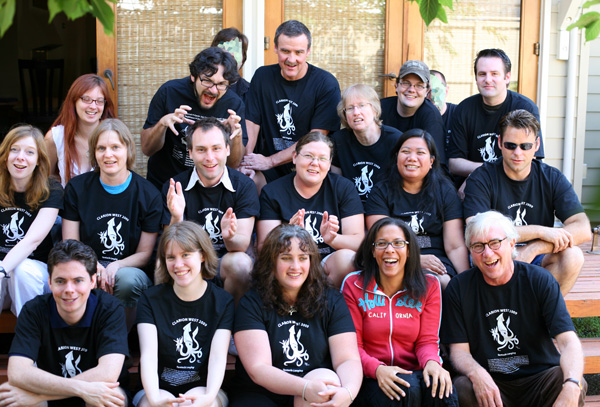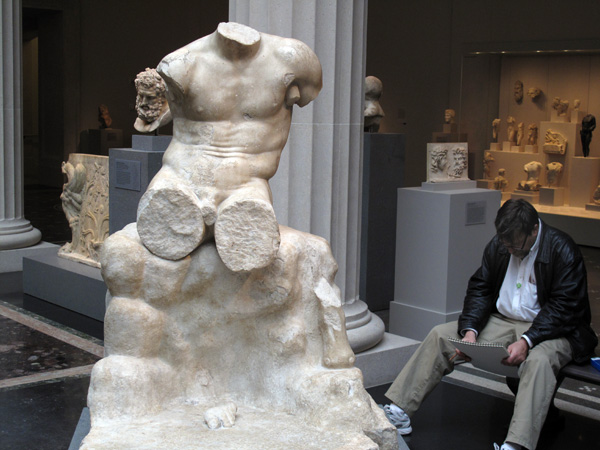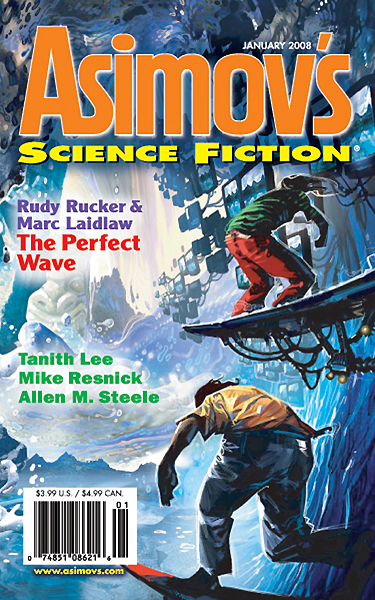This week (July 27 – July 31, 2009) I’ve been teaching some emerging writers here in Seattle at the Clarion West workshop in Seattle. It’s a full schedule, with all the group workshopping of stories, one-on-one conferences, and reading the stories to be workshopped the next day. Many thanks, by the way, to the organizers, Leslie Howle and Neile Graham.
It’s been interesting for me to read so many different types of stories, and to hear the students’ concerns and ideas. It reminds me of my original sense of SF as vast and dreamy. As the days go by, my head swims more and more.

[Rudy and the 2009 Clarion West class on graduation day. Photo by Leslie Howle. Click picture for larger image. Here are the names of the people in the picture listed left to right, from first to last rows: First row: Joel Walsh, Miranda Shevertalov, Kris Millering, LaShenda Vavra, Rudy Rucker. Second row: Siobhan Carroll a.k.a. Von Carr, Julia Sidorova, Lucas Johnson, Elizabeth Wasden, Rochita Loenen-Ruiz, Steven Ellmore. Third & Fourth Rows: Emily C. Skaftun, Randy Henderson, William T. Vandemark (photo obscured), Tom Rodgers, Vicki Saunders, Nate Parkes, Derek Muir (photo obscured), Jordan Lapp.]
I’d imagined that, while I’m here, I might write a transreal story about teaching writing, but I feel a little too scattered for that. The temperature’s been in the 100s, which doesn’t help. But I do want to write something—my way of getting my head together.
So what I’ll do is to work up some Q & A here, adding to this one post as the week goes by. This is by way of amplification to the “Writer’s Toolkit” document that I use when I talk about writing, (in fact some of these notes may end up in there).
I’ll order the entry additions in blog style, that is, with the more recent ones first.

July 31, 2009
A few final points:
Write what you love. Let the market follow you instead of the other way around. Use your whole self. Don’t hold back, don’t be embarrassed to write wild. Push for publication. If you can’t sell, enjoy it anyway…and consider starting a webzine with some friends. Writing is self discovery. Believe in the Muse.
Graduation day!
Today I led my class into the basement of the sorority house on the U.W. campus where I’m lodged, into a room which serves as a little temple or meeting place for the sorors, a room complete with an oil lamp, the Aladdin-kind that you see used in graphics to symbolize WISDOM.
In the same rhythm as that golden oldie chant, “Om Mane Padme Hum,” we chanted these lines over and over—and enlightenment descended. The Eleusinian Mysteries of F & SF!
Time, saucers, sex and goo
Elves, mutants, robots too
Muse of strangeness old and new
My blank pages call to you.
We really got into the sing-song, doing it mantra style, Gregorian style, and, at the end, as a sweet chorus. It was one of those experiences that sticks in my mind, a milepost. I think it’ll stay with some of the students, too. I wanted them to understand about the Muse. In the end that’s what you have to count on. In a way, that’s the most important thing I could teach them.

July 30, 2009
I’m still having trouble finding good endings for my stories. What more can I do?
Don’t settle for a trailing off ending. In high literature, this is fairly acceptable—to have a story where, at the end, the characters are in for more of the same boring and depressing life as usual. Sometimes younger writers think this kind of ending presents a fresh insight about life. But, it’s very well known among adults that life is hard and boring, often unexciting, and filled with ultimately irresolvable problems.
People who read science fiction and fantasy stories are generally looking for a relief from life’s dreariness. They would prefer, I think, to see a happy ending or at least a tight and exciting ending. An ending where something happens, a moment when life seems to make sense, an instant when a higher order shines through the dull machinations of fate.

Thinking of a nice ending can be hard. You want to jump out of the system of your story a little bit, to reach out for a greater synthesis. How?
First of all, it helps to understand what your story is really about. Think about the transreal aspects of your story—the very fact that you picked its topics indicates that these themes and situations have some special meaning for you. What does your story stand for in terms of your personal and emotional life? How might some resolution be found to the problems here suggested?
You have to put your whole heart and soul into the story in order to really get it off the ground. That means you want to think about it all the time—or at least a lot of the time—for days and maybe even weeks on end. Look for clues to the story in the debris on the street, in the faces of the people you meet, and in the flow of media that cascades over your head.
Most of all, you’re waiting for the Muse. If you sincerely seek her, the Muse will come. Sometimes you won’t realize that she’s speaking to you. You’ll think you’re just having a crazy, impractical idea. Stay alert, and notice what you are given. Before long, the proper ending for your story will come.

July 28, 2009
I’m trying to get the students to write some transreal stories, but it’s a little hard to redirect the flowing stream of the workshop. This is the last week of six, so a lot of momentum has built up. They’re into rewriting some of the stories from earlier weeks—which is what last week’s teacher, David Hartwell, set them to doing. That’s okay, too. It’s all F & SF.
How do you write a transreal story?
A transreal story is strongly based on some real situation in the author’s own life. The idea is to build up the characters on the basis of yourself and the other people you know—possibly merging people or reassembling parts of personalities. Take some issue that concerns you and think of some classic SF or fantasy riff that in some way represents this concern. Dial it up and put in a twist at the end if possible. Imagine that your fictional character finds his or her way through the problem that’s bothering you. Note that the story needn’t look especially different from any other SF story, that is, we’re not looking for a deeply emotional True Confessions tale. In other words, don’t let the “real” overwhelm the “trans.” You’re still writing SF. But you’re using the “real” to keep the characters from being flat or plastic.

I feel like my stories are quite well-written, but that I need just another step to make them commercially publishable. What can I do?
The stories might already be good enough, be sure to try a lot of markets. Also keep in mind that, in general, you’ll get a little better with each story that you write. But here’s a few basic things you might try to kick the story up a level.
Make sure that your characters aren’t too flat and generic. You don’t want your hero or heroine to be totally good and right and courageous. They need to have some edges, some quirks. This is why I often recommend thinking of some actual people you know when designing your characters. In the same vein, try not have the dialog be too smooth and scripted. Pay attention to the way people actually talk—they blurt, they argue, they lose the thread, they go off on tangents.
Another useful principle is to give the reader some gnarly and interesting things to contemplate. In a movie, special effects add millions to the budget, but in a story it only takes a few hundred words. It’s always good to describe some specific science-fictional objects to about—little devices or creatures or knots in space. This is an instance of the old “show don’t tell” principle. Rather than having two people discussing some theory, have one of them pull out, like, an egg with a claw sticking out, and the claw blossoms into a flower…that kind of thing.
It’s also good to bring in your special fantastic or science-fiction miracles early in the tale. Don’t make the reader wade through most of the story before something exciting happens. Hit them with a wild new development quite early on, and then you can play with the consequences, maybe piling on some extra quirks as you move towards the conclusion.
July 27, 2009

What is a story, as opposed to a novel?
I see a story as being something like a paperweight—a blown lump of glass with some kind of crack or pattern in it. You can hold it in your hands, you can see the whole thing at once, it’s transparent. But there’s this weird flaw or fault-surface line inside that makes it interesting. Flaw and fault in the geologic or materials science sense—not in the sense of there being something wrong—although, in a way, the interesting parts of a story are when something goes “wrong” for the characters.

What about ending a story?
It’s best if the ending is a twist or a “reveal”—some unexpected consequence of the assumptions in the story. Let me back up on that. I like to refer to the standard fantasy and SF tropes or scenarios as being “power chords.” For a story, you generally select two power chords and work with them, jamming them up against each other, extending them, trying to think of a new way that a given power chord (like telepathy or time travel) might be actualized in a fictional world. And if you think about the situation enough, you can, with luck and inspiration, come up with a twist.
If you can’t think of a twist, you can always go for spiritual uplift. The main character achieves insight into their big problem and rises above it. Or a couple finally declares their love for each other. Or someone gets out of jail (which is, come to think of it, an objective correlative for spiritual uplift). But you do need something.

How do you know when a story is done?
It sometems takes me six or seven to finish a story—including the preliminary passes when the story isn’t written through to the end yet. After each pass, I print it out and go outside, or to a coffee shop, and read the new version, marking it up, and trying to figure out where it’s going and how I’m going to end it. At some point, I feel like the story is done—that is, I’m not seeing more things to mark up and change.
But some stories come out whole, really in one pass, with maybe a few small tweaks afterwards. These are more like pieces of calligraphic paintings, single gestures that cohere into an attractive, gnarly shape. When I’m fortunate enough to come up with a story like this, I try not to overwork it.

How do you sell a story?
When It’s done, I email or snailmail it to an editor—some magazines only take snailmail—and if it comes back, I send it back out again right away, like the very same day. I used to work my way down to lower-and-lower status publishers, but now, if I can’t sell the story to, like Asimov’s or Tor.com or maybe Interzone or some kind of original-story anthology, I just short-circuit the process and put the story in my own webzine, Flurb.
Sometimes, if the story seems non-commercial, I just earmark it for Flurb right away. It’s good to have your own webzine. With some promo and help from other authors, you might be able to get a lot of people to read it. Obviously it’s important to cajole others into your zine so it doesn’t look like a total vanity project. At this point, I publish two stories a year in Flurb, although sometimes my pieces aren’t really stories, they’re chapters of novels in progress.
Thanks to having the Flurb outlet, I’ve given up on sending stories to certain editors—who’ve turned down two or three stories by me. The SF world is small enough that usually these editors are friends. But there’s something about my fiction that doesn’t appeal to them, and there’s no point going through the same rejection over and over again. For any given writer, some markets just aren’t going to work.
This said, when I was a beginning writer, I had a much higher threshold for rejection pain, and would indeed try the same editors over and over and over again. Not that it usually worked. Three Noes tends to mean No forever. It’s nice that the Web has come along to give us another way out. Let a thousand Flurbs bloom!









July 27th, 2009 at 4:59 pm
I’m wondering if you revise your novels as thoroughly as you do your short stories — how many revisions do your novels usually go through?
Also, I’m finding that there’s a lot more slop in my novel than there’s been in my short fiction. I’m just now becoming aware of the amount of material I’ve got on the page that the reader just doesn’t need. Do you have any advice for discerning what needs to be on the page from what just came out during the writing process?
July 27th, 2009 at 8:18 pm
It’s hard to say exactly how many times I revise my novels.
Probably the earlier chapters get revised more often.
While I’m working on a novel, every now and then I’ll print out what I have so far and revise it from the start, just to keep my story threads straight. Even though I have an outline, the outline changes, and I’m often going back and changing things in the earlier chapters, and it takes a close re-read to make sure it’s all straight.
To give the later chapters more attention, I don’t always reprint from the start, like I might just print out the chunk from chap 6 to 10.
When it’s all done I give it another revision, send it off, then usually do another. And there are opportunities for less extensive revisions in the copyediting and (slightly) in proofing stages as well.
July 27th, 2009 at 10:41 pm
Of course some writers never get published in their lifetime, but go on to have huge posthumous success. I recently read
“The Book of Ebenezer Le Page” by G.B.Ebwards,
it’s a total masterpiece, yet he was rejected by publishers during his lifetime.
Reading it made me think of Hylozoic. On page 22 Ebenezer as an old man remembers
when as young boy he inherits from a relative who had passed away,
the two decorative china dogs he still has,
“I like my two china dogs. When I write down anything wicked,
one of them look very serious; but the other one, he wink.”
August 8th, 2009 at 7:05 pm
http://tvtropes.org/pmwiki/pmwiki.php/Main/RecursiveReality
their definition:
“Tropes are storytelling devices and conventions that a writer can reasonably rely on as being present in the audience members’ minds and expectations.”
all quite useful as algosystems for running infinitely-recursive massively-multiple parallel worldsystems on a superdupercomputer network of networks of networlds, yes?
http://tvtropes.org/pmwiki/pmwiki.php/Main/PlotHoles
August 9th, 2009 at 12:13 am
a ‘vortext’:
“spiritually uplifting” (up-ward spir-aling) short text, meant to be read over & over:
record a shortstory as mp3, and loop listen
are there any “branching children’s books” that are semiclosed-paths (wreaths, toroidal) instead of basically linear accelerators?
( skip ‘ahead’ to page number nine if want to take both the red & the blue paths )
i imagine that a style of metaphoric ambitextuality would evolve, as one wrote, or read, such a revolver-go-round.
“ergroundergroundergroUnd”
Aroundabout in Underland?
“Begin in the middle and go on till you get back to where you started: then go round again.”
( now, please mentally connect any two words from column A & column B, then continue reading )
burroughs and cage would say shuffle-listen to fragmented parts.
but a linear story could be designed as a slingshot. or not.
james joyce’s riverrun is certainly …
August 24th, 2009 at 10:17 pm
Hi Rudy, what a lovely post. It’s wonderful to see what the other Clarion was up to while we were bleeding words down in San Diego (Week 6, that would be our Week 5 for us and the start of a lovely stewardship from Liz Hand and Paul Park).
I’m somewhat bumblingly collecting posts about the Clarion experience here http://lizargall.com/2009/03/clarion-blogs/ and have linked to you.
Best wishes
Liz